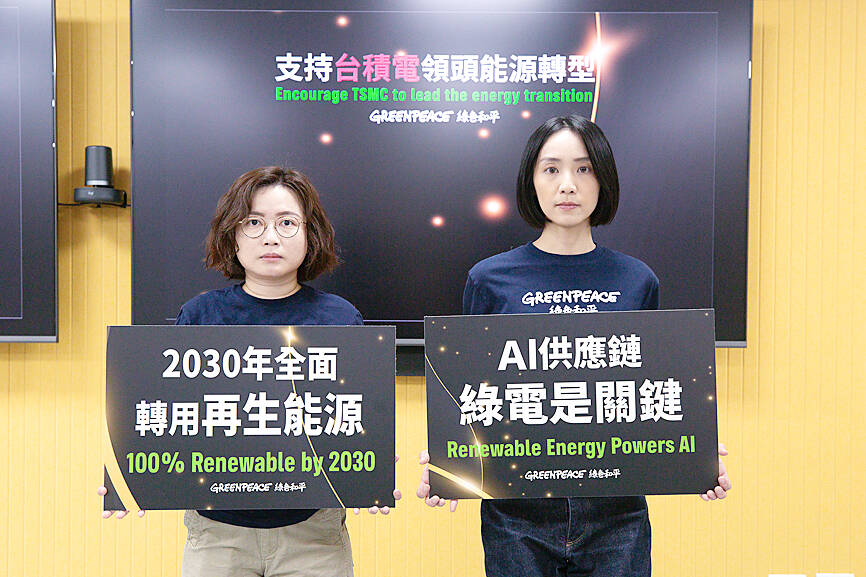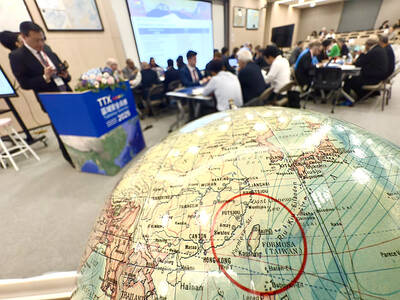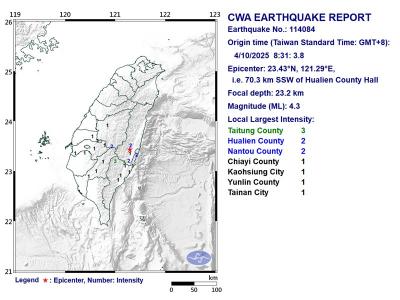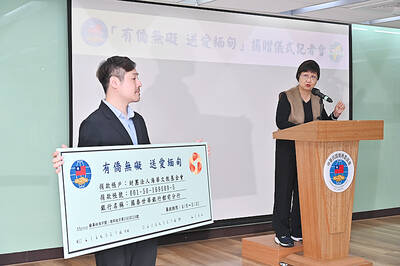Taiwan Semiconductor Manufacturing Co (TSMC) should lead the green power transition to help offset the artificial intelligence (AI) industry’s massive power consumption and reduce fossil fuel use, Greenpeace said yesterday, urging the Ministry of Economic Affairs to aid the effort.
The domestic AI chipmaking industry used 375.8 gigawatt-hours of power last year, up 350.6 percent from 2023, accounting for up to 38 percent of AI chipmaking power consumption globally, a Greenpeace report said.
Its carbon emissions soared more than fourfold to 185,700 tonnes from 41,200 tonnes over the same period and surpassed its South Korea equivalent, which rose to 135,900 tonnes from 58,000 tonnes, it said.

Photo courtesy of Greenpeace
Global AI chipmaking carbon emissions also rose to 453,600 tonnes last year from 99,200 tonnes in 2023, the report said, adding that the increase was mainly due to the industry’s heavy reliance on fossil fuels in East Asia.
Greenpeace East Asia climate and energy campaigner Lena Chang (張皪心) told a news conference that insufficient use of renewable energy would threaten the environment and economy, as Taiwan’s reliance on fossil fuels would increase and exacerbate Taiwan Power Co’s (Taipower) deficit.
“TSMC’s carbon emissions were nearly 11.42 million tonnes in 2023, equivalent to the combined annual emissions of four fossil fuel power plants in Taichung,” Chang said.
Taipower’s deficit from 2022 to last year escalated primarily because it bore the increased costs of importing fossil fuels, while TSMC consumed up to 205 kilowatt-hours of power at its domestic fabs in 2023, Chang said.
“Based on Taipower’s average deficit of NT$0.9 per kilowatt-hour of electricity in 2023, TSMC pushed up Taipower’s deficit by NT$18.4 billion [US$559.82 million] over the period, or a nearly 10 percent increase in its annual deficit,” she said.
Chipmakers and suppliers are generating an increasingly large power demand and reaping the “AI dividend,” while Taipower’s deficit amounted to NT$420 billion last year and would be borne by the public, Chang said, calling for a green power transition to cut the deficit.
S&P Global Ratings data showed that TSMC’s power consumption made up 8.4 percent of domestic power consumption in 2023 and the figure is projected to climb to 23.7 percent in 2030, she said.
Therefore, power shortage and carbon reduction efforts would face tougher challenges if TSMC continues to rely heavily on power from fossil fuels, Chang said.
“A strong commitment by the semiconductor industry to procure low carbon energy at scale would support investor confidence, stimulate economic growth and reduce Taiwan’s reliance on imported fossil fuels,” she said, citing a Semiconductor Equipment and Materials International report.
It has become a global trend for companies to shift from passive green power consumers to active manufacturers and sellers, as direct investments in renewable energy can ensure stable power supply and reduce power costs in the long term, Chang said.
For example, Google achieved 100 percent renewable energy use in 2017 and continued to ratchet it up with its increasing power consumption over the following years, she said.
The company last year announced a joint investment with its Taiwanese supply chain of 1 gigawatt of solar power construction in Taiwan, of which 300 megawatts would be bought back by Google to run its data center and offices, while the rest could be used to aid domestic suppliers’ carbon reduction efforts, Chang said.
TSMC could help Taiwan address the dual challenges of increased US tariffs and increasing power consumption by leading the industry’s green power transition, including targeting 100 percent renewable energy use by 2030 rather than 2040, she said.
The Ministry of Economic Affairs should integrate resources to help companies invest in green energy, as well as enhance the carbon emissions trading mechanism to provide reliable information on sources, quantities and prices of green energy for sellers and buyers, Chang said.
Asked whether nuclear power could substitute for green power, Chang said that nuclear power accounts for less than 5 percent of domestic power generation and is unlikely to meet the power demand of the semiconductor and electrical components industries.
Research shows that the cost of companies’ self-generated solar power could be lower than NT$3 per kilowatt-hour, she said, calling on TSMC to explore the use of diverse renewable energy such as wind or thermal to ensure power supply stability.

DEFENSE: The National Security Bureau promised to expand communication and intelligence cooperation with global partners and enhance its strategic analytical skills China has not only increased military exercises and “gray zone” tactics against Taiwan this year, but also continues to recruit military personnel for espionage, the National Security Bureau (NSB) said yesterday in a report to the Legislative Yuan. The bureau submitted the report ahead of NSB Director-General Tsai Ming-yen’s (蔡明彥) appearance before the Foreign and National Defense Committee today. Last year, the Chinese People’s Liberation Army (PLA) conducted “Joint Sword-2024A and B” military exercises targeting Taiwan and carried out 40 combat readiness patrols, the bureau said. In addition, Chinese military aircraft entered Taiwan’s airspace 3,070 times last year, up about

Taiwan is stepping up plans to create self-sufficient supply chains for combat drones and increase foreign orders from the US to counter China’s numerical superiority, a defense official said on Saturday. Commenting on condition of anonymity, the official said the nation’s armed forces are in agreement with US Admiral Samuel Paparo’s assessment that Taiwan’s military must be prepared to turn the nation’s waters into a “hellscape” for the Chinese People’s Liberation Army (PLA). Paparo, the commander of the US Indo-Pacific Command, reiterated the concept during a Congressional hearing in Washington on Wednesday. He first coined the term in a security conference last

A magnitude 4.3 earthquake struck eastern Taiwan's Hualien County at 8:31am today, according to the Central Weather Administration (CWA). The epicenter of the temblor was located in Hualien County, about 70.3 kilometers south southwest of Hualien County Hall, at a depth of 23.2km, according to the administration. There were no immediate reports of damage resulting from the quake. The earthquake's intensity, which gauges the actual effect of a temblor, was highest in Taitung County, where it measured 3 on Taiwan's 7-tier intensity scale. The quake also measured an intensity of 2 in Hualien and Nantou counties, the CWA said.

The Overseas Community Affairs Council (OCAC) yesterday announced a fundraising campaign to support survivors of the magnitude 7.7 earthquake that struck Myanmar on March 28, with two prayer events scheduled in Taipei and Taichung later this week. “While initial rescue operations have concluded [in Myanmar], many survivors are now facing increasingly difficult living conditions,” OCAC Minister Hsu Chia-ching (徐佳青) told a news conference in Taipei. The fundraising campaign, which runs through May 31, is focused on supporting the reconstruction of damaged overseas compatriot schools, assisting students from Myanmar in Taiwan, and providing essential items, such as drinking water, food and medical supplies,